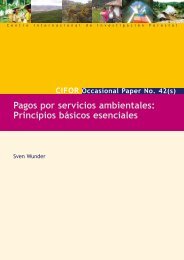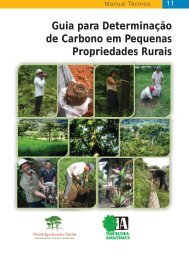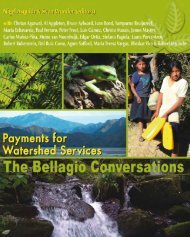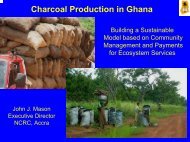Contracting for Forest Carbon : Elements of a Model ... - Forest Trends
Contracting for Forest Carbon : Elements of a Model ... - Forest Trends
Contracting for Forest Carbon : Elements of a Model ... - Forest Trends
- No tags were found...
You also want an ePaper? Increase the reach of your titles
YUMPU automatically turns print PDFs into web optimized ePapers that Google loves.
<strong>Contracting</strong> <strong>for</strong> <strong>Forest</strong> <strong>Carbon</strong>:<strong>Elements</strong> <strong>of</strong> a <strong>Model</strong> <strong>Forest</strong> <strong>Carbon</strong> Purchase Agreementi
This work was made possible by:ii
<strong>Contracting</strong> <strong>for</strong> <strong>Forest</strong> <strong>Carbon</strong>:<strong>Elements</strong> <strong>of</strong> a <strong>Model</strong> <strong>Forest</strong> <strong>Carbon</strong> Purchase AgreementSlayde HawkinsMichelle NowlinDaniel RibeiroRyan StoaRyke LongestJim SalzmanLegal Advisor & Policy Analyst, Katoomba Group – <strong>Forest</strong> <strong>Trends</strong>Supervising Attorney & Senior Lecturing Fellow,Duke Environmental Law & Policy ClinicAssociate In Research, Duke Environmental Law & Policy ClinicAssociate in Research, Duke Environmental Law & Policy ClinicDirector & Senior Lecturing Fellow,Duke Environmental Law & Policy ClinicSamuel F. Mordecai Pr<strong>of</strong>essor <strong>of</strong> Law and Nicolas Institute Pr<strong>of</strong>essor <strong>of</strong>Environmental Policy, Duke UniversityDecember 2010iii
Table <strong>of</strong> ContentsIntroduction ....................................................................................................................... 1Introducing the Transaction and the Parties ......................................................................... 3Title, Introduction, and Recitals ................................................................................................... 3Parties ........................................................................................................................................... 3The Body <strong>of</strong> the Agreement: Rights and Responsibilities ....................................................... 4The Project ................................................................................................................................... 4Delivery ........................................................................................................................................ 6Price and Payment ........................................................................................................................ 6Taxes ............................................................................................................................................ 8Representations............................................................................................................................. 9Validation and Verification ......................................................................................................... 11Default and Remedies ................................................................................................................. 13Force Majeure ......................................................................................................................... 13Failure to Make or Accept Delivery......................................................................................... 14Event <strong>of</strong> Default ..................................................................................................................... 15Remedies ................................................................................................................................ 16Dispute Settlement ..................................................................................................................... 17Miscellaneous ............................................................................................................................. 18Interpretation & Definitions ....................................................................................................... 19Interpretation ......................................................................................................................... 19Definitions ............................................................................................................................. 20Wrapping Up: Signatures and Annexes .............................................................................. 22Signatures ................................................................................................................................... 22Annexes ...................................................................................................................................... 22Conclusion ....................................................................................................................... 23Additional Resources ......................................................................................................... 23Works Cited ..................................................................................................................... 25v
AcknowledgmentsA joint project between <strong>Forest</strong> <strong>Trends</strong> - Katoomba Group and the Duke Environmental Law and PolicyClinic, this report draws from and complements various other publications. The sample agreement used inthis report is based upon templates developed by others, specifically:• the CERSPA document, available at www.cerspa.com,• the International Emissions Trading Association Emissions Trading Master Agreement <strong>for</strong> the EUScheme, available at http://www.ieta.org/ieta/www/pages/getfile.php?docID=194,• and template contracts <strong>for</strong> ecosystem services transactions developed by Mark Ellis-Jones <strong>of</strong> CAREInternational, available at www.katoombagroup.org/legal_contracts.As part <strong>of</strong> a suite <strong>of</strong> publications on carbon markets and transactions, this report complements other <strong>Forest</strong><strong>Trends</strong> publications, including the annual State <strong>of</strong> the Voluntary <strong>Carbon</strong> Market and State <strong>of</strong> the <strong>Forest</strong> <strong>Carbon</strong>Markets reports, and how-to manuals, such as: Getting Started with Payments <strong>for</strong> Ecosystem Services and the<strong>for</strong>thcoming Step-by-Step Guide to <strong>Forest</strong> <strong>Carbon</strong> Projects. We urge readers to refer to these publications <strong>for</strong>additional in<strong>for</strong>mation and guidance.We are grateful to Tauna Szymanski, Michael Jenkins, Johannes Ebeling, Sissel Waage, Jacob Olander, andAnne Thiel, <strong>for</strong> reviewing drafts and providing suggestions.Copyright and Disclaimer© 2010 <strong>Forest</strong> <strong>Trends</strong> and the Katoomba GroupThis report and the featured sample agreement are meant to provide a general introduction to contracting <strong>for</strong><strong>for</strong>est carbon credits and are not intended to be legal advice. The sample contract clauses are illustrative only,and should not be used without significant additions and customization, as relevant to the particularcircumstances <strong>of</strong> the transaction.Duke Environmental Law and Policy Clinic, <strong>Forest</strong> <strong>Trends</strong>, and the Katoomba Group (and their respectiveaffiliates, <strong>of</strong>ficers, directors, partners and employees) do not make any representations or warranties as to theaccuracy, suitability or content <strong>of</strong> this report or the sample agreement and have no liability or responsibility<strong>for</strong> any damages or losses resulting out <strong>of</strong> their use in the individual case in any jurisdiction. It is the soleresponsibility <strong>of</strong> the reader to ensure that the in<strong>for</strong>mation in this report is accurate, applicable to, and suitablein his or her particular situation be<strong>for</strong>e making any decision based upon this in<strong>for</strong>mation.Use <strong>of</strong> this report, or the sample clauses contained herein, does not create an attorney-client relationshipbetween any person and the Duke Environmental Law and Policy Clinic, <strong>Forest</strong> <strong>Trends</strong> or the KatoombaGroup. It is strongly recommended that the reader consult with a lawyer to determine whether specificin<strong>for</strong>mation is relevant to the reader’s particular situation, and to seek appropriate legal and pr<strong>of</strong>essionaladvice be<strong>for</strong>e entering into any transaction.vi
Introduction<strong>Forest</strong> carbon has the potential to play animportant role in climate mitigation. Scientistsassert that de<strong>for</strong>estation and degradationaccount <strong>for</strong> 15% to 20% <strong>of</strong> CO 2 emissions. 1Other reports, including The Stern Review, TheEliasch Review, and research by McKinsey andCompany, support the halting <strong>of</strong> de<strong>for</strong>estationas a critical and cost-effective means <strong>of</strong> reducingglobal greenhouse gas (GHG) emissions. 2<strong>Forest</strong> carbon payments – payments <strong>for</strong>restoring or planting <strong>for</strong>est, or <strong>for</strong> preventing<strong>for</strong>est degradation or de<strong>for</strong>estation – can help toprevent and reverse <strong>for</strong>est loss. However, <strong>for</strong>estcarbon transactions today raise manychallenging issues <strong>for</strong> participants, includingdifficult legal questions. Despite almost twentyyears <strong>of</strong> transacting <strong>for</strong>est carbon, and morethan 67.8 million tons <strong>of</strong> carbon dioxidetransacted, 3 transaction costs and legal feesremain significant and unpredictable.In addition, the nature <strong>of</strong> <strong>for</strong>est carbon marketsis such that buyers and sellers are likely to be onunequal footing in terms <strong>of</strong> their financialresources and commercial experience. <strong>Forest</strong>carbon sellers tend to be landowners and mayhave little experience with commercialtransactions, whereas <strong>for</strong>est carbon buyers aregenerally economically sophisticated companiesand carbon brokers.1Solomon, S. et al. 2007; van der Werf, G. et al.2009; Rogner, H. & Dadi Zhou et al. 2007.2Stern, N. 2006; Eliasch, J. 2008; Enkvist, P. et al.2007.3Hamilton, K. et al. 2010.Box 1. Types <strong>of</strong> <strong>Forest</strong> <strong>Carbon</strong> ProjectsDifferent activities can <strong>for</strong>m the basis <strong>of</strong> a <strong>for</strong>estcarbon project, including:• Af<strong>for</strong>estation – planting and raising trees inareas that were not <strong>for</strong>ested in recenthistory.• Re<strong>for</strong>estation – planting and raising <strong>for</strong>estin areas that were <strong>for</strong>ested in recent history.• Improved <strong>for</strong>est management (IFM) –engaging in land management activities thatenhance carbon stocks in <strong>for</strong>est.• Reducing emissions from de<strong>for</strong>estationand degradation (REDD) – protectingexisting <strong>for</strong>ests from degradation orde<strong>for</strong>estation that would otherwise occur,thereby avoiding carbon emissions.• REDD+ or REDD++ – according to theUnited Nations REDD Program, “REDD+goes beyond de<strong>for</strong>estation and <strong>for</strong>estdegradation and includes the role <strong>of</strong>conservation, sustainable management <strong>of</strong><strong>for</strong>ests, and enhancement <strong>of</strong> <strong>for</strong>est carbonstocks.” 4 REDD++ refers to a broader suite<strong>of</strong> land-use activities, including things likeagriculture, and land management.In order to lower legal costs <strong>of</strong> <strong>for</strong>est carbontransactions and help to level the playing fieldbetween buyers and sellers, this documentguides the reader through a sample <strong>for</strong>est carbonemission reductions purchase agreement(ERPA). The discussion outlines issues that ariseduring pre-negotiation, negotiation, andcontracting, while sample contract clausesillustrate the discussion and provide examples <strong>of</strong>relevant contractual language.4UN-REDD Programme 2010.<strong>Contracting</strong> <strong>for</strong> <strong>Forest</strong> <strong>Carbon</strong> | 1
Legal costs make up a significant, and <strong>of</strong>tenoverlooked, share <strong>of</strong> <strong>for</strong>est carbon transactioncosts. By providing readers – whether sellers,buyers, lawyers, or other stakeholders – with anunderstanding <strong>of</strong> <strong>for</strong>est carbon legal issues, aswell as a basic familiarity with contractuallanguage, this document can help to reducethese costs.Box 2. Emission Reductions and VerifiedEmission ReductionsEmission reductions (ERs) represent net carbon(or CO2 equivalent) emission reductions oradditional carbon storage, in tons, due to a<strong>for</strong>est carbon project.Successful validation and verification <strong>of</strong>emission reductions to an external standard –<strong>for</strong> example, the Voluntary <strong>Carbon</strong> Standard –trans<strong>for</strong>ms ERs into verified emission reductions(VERs), a marketable commodity.The sample agreement in this documentinvolves multiple sellers, represented in theagreement by a single individual, and a <strong>for</strong>wardpurchase <strong>of</strong> VERs on the voluntary carbonmarket. “Forward” refers to the fact that partiesagree to the purchase and sale <strong>of</strong> VERs that havenot yet been created.A <strong>for</strong>ward emission reductions purchaseagreement is by no means the only way tostructure investments in <strong>for</strong>est carbon projects.Another option is to use private equity financingto give the investor some rights to eventualrevenues, and possibly a degree <strong>of</strong> control overproject activities, in return <strong>for</strong> early-stageinvestment. At the other end <strong>of</strong> the projectcycle, a buyer may make a “spot” purchase <strong>of</strong>VERs that have already been generated andissued, virtually eliminating the buyer’s exposureto project risks and allowing the seller to ask <strong>for</strong>a higher price per VER. Different investmentand purchase options involve trade-<strong>of</strong>fs betweenprice, risk, level <strong>of</strong> control, and other factors.This document discusses a <strong>for</strong>ward sale <strong>of</strong> VERsas opposed to some other investment orpurchase agreement <strong>for</strong> several reasons. First, the<strong>for</strong>ward sale tends to be an attractive option <strong>for</strong><strong>for</strong>est carbon sellers that need up-frontfinancing, help with project costs, and/orsharing <strong>of</strong> project risks with an investor orbuyer. Second, an emission reductions purchaseagreement can be relatively standardized, yetremain customizable <strong>for</strong> specific transactions,making it well-suited <strong>for</strong> use in a guidancedocument such as this one. Third, <strong>for</strong>wardpurchase agreements raise <strong>for</strong>est-carbon-specificissues related to project activities, advancepayments, default and remedies clauses, andother issues, in a way that spot purchaseagreements, <strong>for</strong> example, do not. This type <strong>of</strong>agreement there<strong>for</strong>e provides a good framework<strong>for</strong> discussing negotiation and contracting issuesthat are in some way unique or specific to <strong>for</strong>estcarbon.While the authors have made every ef<strong>for</strong>t toensure that the in<strong>for</strong>mation provided is relevantto <strong>for</strong>est carbon project participants generally,different issues will arise in every case. Readersthere<strong>for</strong>e should not rely upon the in<strong>for</strong>mationprovided here <strong>for</strong> legal advice, but should seekout experienced legal support appropriate totheir particular circumstances.<strong>Contracting</strong> <strong>for</strong> <strong>Forest</strong> <strong>Carbon</strong> | 2
Introducing the Transactionand the PartiesTitle, Introduction, and RecitalsThe <strong>for</strong>est carbon agreement will have a title,which should be simple but descriptive but neednot include the names <strong>of</strong> the parties. Theintroduction follows, in the <strong>for</strong>m <strong>of</strong> a shortparagraph identifying the parties and the date <strong>of</strong>the agreement. The principal, legal, or registeredaddresses <strong>of</strong> the parties are generally listed here.The date <strong>of</strong> the contract should ideally be thedate <strong>of</strong> signing <strong>for</strong> the last party to sign theagreement.Next come the recitals, which include anybackground in<strong>for</strong>mation that the parties think isrelevant. Recitals may include a description <strong>of</strong>the goals <strong>of</strong> the agreement along withbackground in<strong>for</strong>mation about the project, theparties, and any relevant agreements betweenthe parties or any party and one or more thirdparties. The recitals should not contain anybinding obligations.The introductory part <strong>of</strong> the agreement endswith a lead-in sentence indicating that “theparties agree as follows,” as shown in Box 1.Box 1. Sample Beginning <strong>of</strong> an AgreementFOREST CARBON EMISSIONREDUCTIONS PURCHASEAGREEMENTThis <strong>for</strong>est carbon emission reductions purchaseagreement is dated , and isbetween Seller Representative Assn., a Braziliannon-pr<strong>of</strong>it association (the “SellerRepresentative”), and Investor Corp., aDelaware corporation (the “Buyer”).RECITALSThe Seller Representative and participatingmembers <strong>of</strong> the Ecosystem Service ProviderCommunity (“Participating Landholders”) areparty to an agreement dated ,concerning the authority <strong>of</strong> the SellerRepresentative to represent the ParticipatingLandholders with respect to <strong>for</strong>est carbontransactions on land under the control <strong>of</strong> theParticipating Landholders.Participating Landholders wish to undertakeland management activities in order to reduceemissions from de<strong>for</strong>estation and degradationand enhance carbon sequestration in <strong>for</strong>estsunder their control (the “Project”).The Buyer wishes to pay ParticipatingLandholders <strong>for</strong> the right to claim credit <strong>for</strong>emission reductions or additional sequestrationgenerated by the land management activities <strong>of</strong>Participating Landholders.The parties there<strong>for</strong>e agree as follows:PartiesIn its simplest <strong>for</strong>m, a purchase agreement isbetween two parties: a buyer and a seller. A<strong>for</strong>est carbon purchase transaction, however,may involve multiple sellers – perhaps evenwhole communities – and multiple buyers.Generally speaking, the more parties areinvolved, the higher the administrative andtransaction costs will be. The additional cost,and potential risk, can and should be mitigatedby the use <strong>of</strong> one or more intermediary entitiesto: (1) represent the sellers as a collective unit innegotiating with third parties, including buyers,(2) oversee project development andgovernance, and (3) manage collection anddisbursement <strong>of</strong> revenues.Where multiple sellers are involved, sellersshould ideally agree to be represented by a single<strong>Contracting</strong> <strong>for</strong> <strong>Forest</strong> <strong>Carbon</strong> | 3
individual or entity – a sellers’ representative –who will be authorized to negotiate with buyersand any third parties involved in the project onbehalf <strong>of</strong> the sellers as a group. Differentjurisdictions are likely to have distinct legalrequirements <strong>for</strong> authorizing a third party to acton behalf <strong>of</strong> sellers. Accordingly, sellers will haveto consult local counsel to ensure compliancewith the law.Potential buyers will verify the capacity andauthority <strong>of</strong> the sellers’ representative as part <strong>of</strong>the due diligence process, in order to avoidpotential disputes over authorization that candisrupt project activities. Buyers may also needassurances that they are dealing with a valid,authorized entity so as not to violate antimoney-laundering laws in their home country.The sellers’ representative may also be entrustedwith leading project development and design, aswell as project governance once the project is upand running. The sample agreement assumesthat the project is already underway. There<strong>for</strong>e,it deals with project governance but not projectdevelopment.Good, transparent project governance, withrobust procedures in place to resolve disputesand facilitate participatory collective decisionmaking,can be expected to reduce the cost tosellers <strong>of</strong> administering the project and tocontribute to the project’s success. Projectgovernance provisions should be agreed on byall sellers in advance, and entrusted to a singleindividual or entity to ensure that they arecarried out as agreed.In addition, the sellers’ representative may beauthorized to collect revenues from buyers anddisburse funds to sellers according to agreedprocedures. Alternatively, this role may begranted to a separate entity – a trust fund, <strong>for</strong>example – that will be in charge <strong>of</strong> fundsmanagement.Procedures <strong>for</strong> seller representation, projectgovernance, and funds management must beagreed in advance between all sellers, the sellers’representative and any other participatingentities, and outlined in one or more writtenagreements. For the sake <strong>of</strong> simplicity, thesample purchase agreement described in thisdocument assumes that the sellers’ representativeis properly authorized in a single agreement withall sellers to both negotiate on behalf <strong>of</strong> thesellers (“Participating Landholders” in thesample agreement), as well as to oversee projectgovernance and manage project funds.On the buyer side, the sample purchaseagreement considers a single buyer. It isrecommended that sellers execute a separatepurchase agreement with each buyer.In some cases, the government may participatein <strong>for</strong>est carbon projects as a buyer or a seller.Such government involvement will raise uniqueissues that are not addressed in this documentbut will be essential to address in thedevelopment <strong>of</strong> successful agreements.The Body <strong>of</strong> the Agreement:Rights and ResponsibilitiesThe Project<strong>Forest</strong> carbon sellers can generate net emissionreductions by: (1) reducing <strong>for</strong>est emissionsfrom de<strong>for</strong>estation and degradation and (2)increasing the amount <strong>of</strong> carbon stored in<strong>for</strong>ests via re<strong>for</strong>estation, restoration, orimproved <strong>for</strong>est management.Emission reductions, however, do not becomereadily marketable commodities until they arevalidated and verified to an external standardand become verified emission reductions (VER).In theory, any VER that is verified to a certainstandard is equivalent to any other VER verifiedto that standard, regardless <strong>of</strong> how it wascreated. This approach provides the basis <strong>for</strong>trading VER on carbon markets. In practicehowever, VERs will sell <strong>for</strong> different prices<strong>Contracting</strong> <strong>for</strong> <strong>Forest</strong> <strong>Carbon</strong> | 4
depending upon where the project is located andother circumstances. For example, a VER from acommunity-based <strong>for</strong>est carbon project can besold at a higher price than a VER from a projectthat reduces methane emissions from landfills.VER may either be sold after they are created –in a ‘spot’ sale – or they may be sold ahead <strong>of</strong>time in a ‘<strong>for</strong>ward’ sale. The spot price <strong>for</strong> VERis substantially higher than the <strong>for</strong>ward price,because the buyer bears no project risk. On theother hand, sellers may prefer <strong>for</strong>ward sales,which provide up-front funding <strong>for</strong> projectactivities. In a <strong>for</strong>ward purchase agreement,project activities are a central concern: the sellerpromises to diligently per<strong>for</strong>m activities in orderto maximize the chance that the project willultimately create credits.Due to the desirability (and <strong>of</strong>ten necessity) <strong>of</strong> a<strong>for</strong>ward sale from a seller’s point <strong>of</strong> view, interms <strong>of</strong> providing funds <strong>for</strong> projectdevelopment and sharing project risks, thisdocument focuses on a <strong>for</strong>ward sale <strong>of</strong> VERs.Project activities there<strong>for</strong>e appear at thebeginning <strong>of</strong> the body <strong>of</strong> the agreement.Box 2. Sample Clauses Dealing with <strong>Forest</strong><strong>Carbon</strong> Project ActivitiesArticle 1.Activities.Sale and Purchase; Project1.1 Sale and Purchase. The SellerRepresentative agrees to sell and the Buyeragrees to purchase verified emission reductions(“VERs”) subject to and in accordance with theterms <strong>of</strong> this agreement.1.2 Project Activities. ParticipatingLandholders shall manage their land and <strong>for</strong>estin order to decrease greenhouse gas emissionsfrom de<strong>for</strong>estation and degradation and increasecarbon sequestration (“Project Activities”) inaccordance with the project plan in annex 1 (the“Project Plan”).1.3 Project Area. The land on which theProject Activities will occur (the “ProjectArea”) is the area that is described in annex 2.1.4 Mitigation <strong>of</strong> Risk. ParticipatingLandholders shall manage the Project Area toreduce the risk <strong>of</strong> <strong>for</strong>est loss due to fire,insects, or plant disease as provided in theProject Plan.1.5 Project Governance. The SellerRepresentative shall oversee governance <strong>of</strong> theProject and shall ensure compliance with theproject governance procedures in the ProjectPlan.1.6 Effective Date, Term. This agreementtakes effect upon execution by both parties(the “Effective Date”) and remains in effectuntil delivery <strong>of</strong> all VERs covered by thisagreement or the earlier termination <strong>of</strong> thisagreement in accordance with its terms.In the <strong>for</strong>est carbon context, there is a realdanger that a <strong>for</strong>est fire, insect infestation, orplant disease outbreak could cause the release <strong>of</strong>stored carbon and destroy the transaction.Clause 1.4 assures the buyer that thelandholders will take certain actions to mitigatethe risk <strong>of</strong> <strong>for</strong>est fire, insect infestation, or plantdisease outbreak, as specified in the Project Plan.This clause is important because the landholderscan mitigate such risks, but not eliminate thementirely. For example, sellers can plant mixedtree species, maintain distances between maturetrees, and clear dead brush, as appropriate to the<strong>for</strong>est ecosystem in which the project is situated.The project governance procedures referred toin clause 1.5 must be agreed among allparticipating landholders and the sellers’representative and should include protocol <strong>for</strong>decision-making among participatinglandholders, distribution <strong>of</strong> revenues,transparency, and other project governancematters. Important goals <strong>of</strong> that documentinclude: assurance that there is ongoing free,<strong>Contracting</strong> <strong>for</strong> <strong>Forest</strong> <strong>Carbon</strong> | 5
prior, and in<strong>for</strong>med consent by all participants;provision <strong>for</strong> a fair allocation <strong>of</strong> revenues; andan orderly division <strong>of</strong> responsibility amongparticipants.Project governance procedures should alsoprovide <strong>for</strong> how, if at all, new participatinglandholders may join the project after itcommences. Care should be taken to disallowparticipation by people who have gained rightsin land illegitimately, by coercion, or by <strong>for</strong>ce. Itwill also be important to adjust benefit-sharingappropriately if different landholders participatein project activities <strong>for</strong> different periods <strong>of</strong> time.DeliveryIn any purchase agreement, the seller isobligated to deliver purchased goods or servicesto the buyer. Since <strong>for</strong>est carbon sequestrationoccurs over long periods <strong>of</strong> time, delivery <strong>of</strong>VERs will <strong>of</strong>ten occur over a 15-30 year periodfrom the start <strong>of</strong> project activities.The sample agreement illustrates one commondelivery arrangement <strong>for</strong> a <strong>for</strong>ward carbonpurchase, that is regular deliveries <strong>of</strong> all or aportion <strong>of</strong> the VERs generated by the project <strong>for</strong>the duration <strong>of</strong> the agreement. This approachrecognizes fundamental uncertainties in thetiming and amount <strong>of</strong> VERs that will begenerated by a <strong>for</strong>est carbon project.Delivery <strong>of</strong> VERs generally occurs over anelectronic registry that tracks transfers <strong>of</strong> VERand helps to ensure that no double-counting <strong>of</strong>emission reductions occurs. Responsibility <strong>for</strong>opening and maintaining a registry account, andpaying transfer or other fees, should be allocatedin the agreement.Box 3. Sample Delivery ClauseArticle 2. Delivery <strong>of</strong> Verified EmissionReductions.2.1 Delivery and Acceptance. On June 1, 2012and each June 1 thereafter (the “DeliveryDate”) through June 1, 2026 (the “AgreementTerm”), the Seller Representative shall deliver,and the Buyer shall accept, all <strong>of</strong> the VERsissued to the Project during the preceding yearfrom June 1 to May 31, inclusive (each suchdelivery and acceptance, a “Transaction”).2.2 Registry. The Seller Representative shalldeliver VERs on the Markit VCS Registry orsuch other registry as is agreed in writingbetween the parties (the “Registry”).2.3 Costs. Each party shall pay its own costs <strong>of</strong>opening and maintaining a registry account.The Buyer shall pay all transfer and other feesassessed by the Registry.2.4 No Encumbrance. The Seller Representativeshall not create or permit to exist any claim orencumbrance over the Emission Reductions orthe VER that are the subject <strong>of</strong> this agreement.Price and PaymentThe buyer’s primary obligation is to makepayments in return <strong>for</strong> VERs from projectactivities. In turn, the seller must transfer alllegal rights in the VERs to the buyer. Thistransfer <strong>of</strong> rights is meant to ensure that theseller cannot re-sell the same VER to a differentbuyer. It also provides security <strong>for</strong> the seller,because rights in the VER are only transferredonce full payment occurs (see Box 4, clause 3.8).One <strong>of</strong> the most difficult aspects <strong>of</strong> <strong>for</strong>estcarbon transactions involves the question <strong>of</strong> upfrontpayments. An emission reductionspurchase agreement, like the sample agreement,anticipates that most <strong>of</strong> the payment is dueupon delivery <strong>of</strong> VER. However, many <strong>for</strong>estcarbon sellers, and small-scale sellers inparticular, need payment up front – in the <strong>for</strong>m<strong>Contracting</strong> <strong>for</strong> <strong>Forest</strong> <strong>Carbon</strong> | 6
<strong>of</strong> advance payments – in order to fund projectactivities.Because the buyer bears more risk by paying inadvance, he or she is likely to require adiscounted price and/or an increase in controlover project activities if advance payments areused.In terms <strong>of</strong> the price <strong>for</strong> VERs, the parties mayuse a fixed price or they may tie the price to anindex that accounts <strong>for</strong> price fluctuations overtime. A fixed price is more commonly used.The downside <strong>of</strong> using a fixed price is that theparties cannot be sure until VERs are issuedwhether they made a good deal, relative to thespot price <strong>for</strong> VERs. The parties can limit thisuncertainty by providing that the seller willshare in pr<strong>of</strong>its when the spot price rises above,or in losses when the spot price falls below, a setthreshold. This helps to reduce or eliminate theincentive <strong>for</strong> one party to break the contract dueto a wide discrepancy between the spot priceand the contract price.Alternatively the parties can maintain theirrelative position at all times by using an indexedprice, which takes price fluctuation into accountby tying the price <strong>of</strong> VERs to an external indexsuch as the Bloomberg New Energy FinanceVoluntary <strong>Carbon</strong> Index. The downside <strong>of</strong> anindexed price is that there is uncertain pricinguntil VERs are issued, which creates significantrisk <strong>for</strong> both parties. If an indexed price is used,a minimum price (a floor) and/or a maximumprice (a ceiling) may be used to limit priceuncertainty.Regardless <strong>of</strong> how the price is determined, thesellers must release all claims to VERs whenpayment is delivered <strong>for</strong> those VERs, and notbe<strong>for</strong>e. Doing so establishes a sort <strong>of</strong> lien onVERs that is released only by full payment.Box 4. Sample Price and Payment ClausesArticle 3. Payments.3.1 Price. The Contract Price is U.S. $5 perVER delivered under this agreement.3.2 Statement. As soon as practicable after theDelivery Date <strong>for</strong> a Transaction, the SellerRepresentative shall send to the Buyer a writtenstatement (the "Statement") showing <strong>for</strong> suchTransaction:(a) the quantity <strong>of</strong> VERs delivered;(b) the Contract Price;(c) the date <strong>of</strong> delivery;(d) any amount owing from one party tothe other;(e) the net amount payable from one partyto the other after taking into account all <strong>of</strong> theabove (the “Statement Amount”); and(f) any applicable amount payable underclause 4.1 (VAT Taxes) as a result <strong>of</strong> transfersunder this agreement.3.3 Failure to Issue Statement. If the SellerRepresentative fails to issue a Statement inaccordance with clause 3.2 (Statement), then theBuyer may issue that Statement to the SellerRepresentative and, once issued, that Statementshall be treated as a Statement issued by theSeller <strong>for</strong> the purposes <strong>of</strong> this agreement. Failureto issue a Statement does not affect the rightsand obligations <strong>of</strong> the parties under thisagreement and is not an Event <strong>of</strong> Default as thatterm is defined in clause 9.1.3.4 Payment Due Date. The Payment DueDate is the fifth Banking Day after the later <strong>of</strong>:(i) the Delivery Date and (ii) the date on whichthe Statement is delivered to the buyer inaccordance with clause 3.2 (Statement).<strong>Contracting</strong> <strong>for</strong> <strong>Forest</strong> <strong>Carbon</strong> | 7
3.5 Payment Mechanics. On or be<strong>for</strong>e thePayment Due Date, the Buyer shall transfer theStatement Amount, plus any amounts payableto the Seller Representative under clause 4.1(VAT Taxes) and 4.2 (Other Taxes), in USDollars and by direct bank transfer or equivalenttransfer <strong>of</strong> immediately-available funds, into theaccount specified in Annex 3.3.6 Advance Payments. The Buyer shall makeadvance payments according to the AdvancePayment Schedule in Annex 3 (“AdvancePayments”). Advance Payments directly <strong>of</strong>fsetthe Buyer’s payment liability <strong>for</strong> deliveredVERs.3.7 Sufficient Funds. The Buyer shall maintainsufficient funds to fulfill its obligations underthis agreement, and shall make audited financialreports available to the Seller Representativeupon the Seller Representative’s reasonablerequest.3.8 Transfer <strong>of</strong> Title. No property interest in theVERs will pass to the Buyer until delivery andpayment are complete in accordance with theterms <strong>of</strong> this agreement. Upon such completion,all rights, title and interest in and to the VERs,will transfer to the Buyer. Transfer <strong>of</strong> VERsdoes not transfer eligibility <strong>for</strong> tax credits orother direct third-party subsidies <strong>for</strong> theoperation <strong>of</strong> the Project.These sample price and payment clauses,however, represent only one simplified way <strong>of</strong>dealing with the issues described above, and theyomit several additional issues entirely. Omittedissues, including the three discussed below, canadd substantial complexity if used.First, payments in-kind, in the <strong>for</strong>m <strong>of</strong>equipment, raw materials, technology, ortraining, may be desirable <strong>for</strong> both the buyerand the seller. The <strong>for</strong>m, feasibility, andvaluation <strong>of</strong> in-kind payments depend entirelyupon the circumstances.Second, particularly where the project involvescomplex payouts to various sellers andsupporting entities, or significant prepayment bythe buyer, it is common to use an escrowaccount to transfer payments <strong>for</strong> VER from thebuyer to the seller. Procedures <strong>for</strong> disbursement<strong>of</strong> funds from the escrow account would beoutlined in a separate agreement between theaccount holder (a financial institution), andsellers and supporting entities, if applicable, andmust be in accordance with project governanceand benefit sharing arrangements.Third, if sellers are concerned about the risk thatthe buyer will not have the money to pay whenrequired, sellers can require the buyer tomaintain a letter <strong>of</strong> credit, or sufficient funds, orsome other <strong>for</strong>m <strong>of</strong> per<strong>for</strong>mance assurance.However, per<strong>for</strong>mance assurance can beexpensive and may be hotly contested.TaxesThe agreement must address which party isresponsible <strong>for</strong> taxes assessed in connection withthe agreement. One common tax that must beaddressed is the value-added tax (VAT), which ischarged when a good or service is transferredand is based on the value <strong>of</strong> the good or service.The sample agreement provides that the buyer isresponsible <strong>for</strong> paying VAT. If VAT ischargeable to the sellers’ representative, then thebuyer must pay the sellers’ representative thevalue <strong>of</strong> the tax. Note that where a “ReverseCharge Rule” is part <strong>of</strong> the VAT law in thebuyer’s country, the buyer is responsible <strong>for</strong>calculating and paying VAT directly to the<strong>for</strong>eign government entity that charges the taxand there<strong>for</strong>e need not pay the sellers’representative.<strong>Contracting</strong> <strong>for</strong> <strong>Forest</strong> <strong>Carbon</strong> | 8
Box 5. Sample VAT and Other Tax ClausesArticle 4.Taxes.4.1 VAT Taxes. All amounts referred to in thisagreement are exclusive <strong>of</strong> any value-added taxes(“VAT”) properly chargeable on goods orservices transferred under this agreement.(a) VAT applicability and treatment will bedetermined pursuant to the law <strong>of</strong> thejurisdiction where a transfer subject to VAT isdeemed to take place.(b) On the Payment Due Date, the Buyer shallpay to the Seller Representative an amountequal to the VAT, if any, properly chargeable inthe Seller Representative's jurisdiction <strong>for</strong>transfers under this agreement; provided,however, that (i) such amount need not be paiduntil the Seller Representative provides theBuyer with a valid VAT invoice in relation tothat amount and, (ii) the Buyer is under noobligation to make any payment to the SellerRepresentative in respect <strong>of</strong> VAT which theBuyer must self-assess and pay under the“reverse charge” rule or any similar system in theBuyer's jurisdiction.(c) Each party shall, to the extent permitted bylaw, provide the other with any additional validVAT invoices as required <strong>for</strong> the purposes <strong>of</strong>this agreement and, to the extent required bylaw, shall correctly account <strong>for</strong> any VATproperly due in its jurisdiction.4.2 Other Taxes.(a) Subject to each party's obligations relatingto VAT, each party shall cause all royalties,taxes, duties and other sums (including anystamp duty, other documentary taxes, climatechange levy or other environmental tax or levy)legally payable by that party arising inconnection with this agreement to be paid.(b) In the event that the Seller Representative isrequired by law to pay any tax which is properly<strong>for</strong> the account <strong>of</strong> the Buyer, the Buyer shallpromptly indemnify or reimburse the SellerRepresentative in respect <strong>of</strong> such tax. In theevent that the Buyer is required by law to payany tax which is properly <strong>for</strong> the account <strong>of</strong> theSeller Representative, the Buyer may deduct theamount <strong>of</strong> any such tax from the sums due tothe Seller Representative under this agreementand the Seller Representative shall promptlyindemnify or reimburse the Buyer in respect <strong>of</strong>any such tax not so deducted.In the sample agreement, taxes other than theVAT are allocated to the party to whom they areproperly chargeable. This is a simple solution,though many will prefer to negotiate a differentallocation <strong>of</strong> taxes and other costs.RepresentationsRepresentations are statements <strong>of</strong> fact that aremade by each party to an agreement in order toremove uncertainties and induce the other partyor parties to enter the transaction. For example,each party typically represents that it is legallyauthorized to enter into, and per<strong>for</strong>m itsobligations under, an agreement.Representations should be limited to statements<strong>of</strong> fact, and should not contain <strong>for</strong>ward-lookingstatements or obligations (which are usuallyreferred to as “covenants” and dealt withseparately).In a project involving multiple sellers, the sellersmay want to represent that the project’sgovernance mechanisms facilitate full, prior, andin<strong>for</strong>med consent, enhance transparency orequity, or increase the likelihood <strong>of</strong> projectsuccess.If a party’s representations turn out not to havebeen true when made – known as a failure <strong>of</strong>that party’s representations – then the otherparty will have rights and remedies as specified<strong>Contracting</strong> <strong>for</strong> <strong>Forest</strong> <strong>Carbon</strong> | 9
in the agreement (see Box 11 - Default and Box12 - Remedies).A partial list <strong>of</strong> general representations (made byeach party) appear in Box 8.Box 6. Sample General RepresentationsArticle 5.Representations.5.1 General Representations. Each partyrepresents that:(a) It is duly organized and validly existingunder the laws <strong>of</strong> the jurisdiction <strong>of</strong> itsorganization or incorporation, and, if relevantunder those laws, in good standing.(b) It has the power:(1) to execute this agreement and any otherdocumentation to which it is a party relating tothis agreement;(2) to deliver this agreement and anydocumentation relating to this agreement that itis required by this agreement to deliver; and(3) to per<strong>for</strong>m its obligations under thisagreement,(c) All required authorizations have beenobtained and are in full <strong>for</strong>ce and effect.(d) Execution, delivery, and per<strong>for</strong>mance underthis agreement does not cause it to violate anyapplicable law, statute, contractual obligation, orcourt or government order.(e) Its obligations under this agreement arelegal, valid, and binding, and en<strong>for</strong>ceable inaccordance with their respective terms, subjectto applicable creditors’ rights laws and toequitable principles <strong>of</strong> general application.(f) No Event <strong>of</strong> Default, as that term is definedin Article 9, or event that with notice or lapse <strong>of</strong>time or both would constitute an Event <strong>of</strong>Default, has occurred with respect to it, and nosuch event would occur as a result <strong>of</strong> its enteringinto or per<strong>for</strong>ming its obligations under thisagreement.(g) No litigation, arbitration, or administrativeproceeding be<strong>for</strong>e any governmental entity ispending or, so far as it is aware, threatenedagainst it that would, if adversely determined,result in a material adverse change in itsfinancial condition or its ability to per<strong>for</strong>m itsobligations under this agreement, or that islikely to affect the legality, validity, oren<strong>for</strong>ceability against it <strong>of</strong> this agreement.(h) It has entered into this agreement after a fullopportunity to review its terms and conditions,it has a full understanding <strong>of</strong> these terms andconditions and their risks, and it is capable <strong>of</strong>assuming those risks.(i) It is not relying upon any representations <strong>of</strong>the other party other than those expressly set outin this agreement, and the other party is notacting as a fiduciary or advisor <strong>for</strong> it.(j) All in<strong>for</strong>mation that is identified as beingsubject to or connected with this agreement andthat it provides, or that is provided on its behalf,in writing to the other party is, as <strong>of</strong> the date itis provided, true, accurate, and complete inevery material respect.<strong>Forest</strong> carbon sellers may need to makeadditional representations to the effect thatsellers are legally entitled to sell VERs from theproject area under applicable local and nationallaw. Furthermore, if a sellers’ representative isused, it should represent that it was legallyappointed, after full and fair disclosure, by allparticipating landholders.Box 7. Sample Representations Made by theSellers’ Representative5.2 Seller Representative Representations. TheSeller Representative represents that:(a) Participating Landholders hold use rights inthe Project Area, as shown in the land use grantthat is attached at annex 4, that entitle them toper<strong>for</strong>m, and receive revenue from, ProjectActivities.<strong>Contracting</strong> <strong>for</strong> <strong>Forest</strong> <strong>Carbon</strong> | 10
(b) As shown in the agreement between theSeller Representative and ParticipatingLandholders that is attached at annex 5, theSeller Representative is authorized by theunanimous, free, prior, and in<strong>for</strong>med consent <strong>of</strong>Participating Landholders to act on behalf <strong>of</strong>Participating Landholders and to oversee projectgovernance and distribution <strong>of</strong> revenues asdescribed in the Project Plan.To show the buyer that sellers are legallyentitled to sell VER from their land, sellersmust, at a minimum, demonstrate that:• Sellers have a use right (statutory orcustomary) in the project area that permitsthem to per<strong>for</strong>m project activities andexclude incompatible uses, <strong>for</strong> the fullduration required by the purchaseagreement and the certification standardsused.• Claiming and transferring credit <strong>for</strong>emission reductions within the project areais not contrary to applicable national orlocal law.If the land or natural resources belong to thegovernment, governmental approval may berequired <strong>for</strong> project activities to proceed.It may be good practice to specify thatparticipating landholders have held use rights<strong>for</strong> a minimum period <strong>of</strong> time be<strong>for</strong>e the projectbegan, indicating that they did not recentlyacquire rights in the project area by squatting orappropriation.The function <strong>of</strong> clause 5.2(a) in Box 9 is toassure buyers that the sellers’ representative hasthe free, prior, and in<strong>for</strong>med consent <strong>of</strong> allparticipating landholders to (1) representparticipating landholders, (2) oversee projectgovernance, and (3) manage revenuedistribution. The sellers’ representative will needto attach pro<strong>of</strong> <strong>of</strong> consent, which can be anagreement signed by all participatinglandholders and the sellers’ representative, to thepurchase agreement.Validation and VerificationUsing the Voluntary <strong>Carbon</strong> Standard oranother accepted standard or program <strong>for</strong>assessing the carbon benefits <strong>of</strong> a <strong>for</strong>est carbontransaction provides minimum requirementsand procedures <strong>for</strong> project validation andverification. Most standards, including theVoluntary <strong>Carbon</strong> Standard, additionallyprovide specific methodologies or protocols thatdescribe how the project and its net effects oncarbon emissions are to be assessed in specificcircumstances. For the sake <strong>of</strong> simplicity, thisdocument will use “standards” to refer tocarbon standards or programs and“methodologies” to refer to methodologies orprotocols under those standards.Generally, validation is an evaluation <strong>of</strong> theproject plan and associated documents todetermine whether the project is likely togenerate emission reductions that can satisfy therequirements <strong>of</strong> the chosen standard andmethodology. Monitoring refers to periodicassessments <strong>of</strong> whether the project isaccomplishing its goals. Verification refers to anex-post evaluation <strong>of</strong> whether emissionreductions were generated as planned.Even in the voluntary market, rigorous thirdparty validation and verification is likely to beextremely important to buyers. Where thirdparty validation and verification is used, thepurchase agreement must specify whichstandard, and which <strong>of</strong> the chosen standard’smethodologies, will be used. Alternatively, theagreement can describe the process by which astandard and methodology will be selected.In general, validation and verification must bedone by separate individuals or entities, each <strong>of</strong>which must be approved to per<strong>for</strong>maccreditation under the chosen standard. Due toboth the rigor required and the lack <strong>of</strong> people<strong>Contracting</strong> <strong>for</strong> <strong>Forest</strong> <strong>Carbon</strong> | 11
qualified to per<strong>for</strong>m validation and verification,the time and expense involved is significant andunexpected delays are common. These and othercosts and risks <strong>of</strong> validation and verificationmust be allocated in the purchase agreement.When VERs have been validated and verified toa certain standard, they are “issued” by thestandards organization and entered into acarbon credit registry that tracks the issuanceand ownership <strong>of</strong> VERs.Who will bear the costs <strong>of</strong> validation,verification, issuance, and registration is likely tobe a major issue in a purchase agreement.Assumption <strong>of</strong> some <strong>of</strong> these costs by the buyerprovides a major incentive <strong>for</strong> sellers to use a<strong>for</strong>ward purchase agreement – rather thanselling <strong>for</strong> a higher price on the spot market at alater time.To account <strong>for</strong> changing circumstances, thepurchase agreement should contain a process <strong>for</strong>changing the chosen standard and methodologyin order to allow the parties to adapt. Forexample, new national law or internationaltreaty may require or prefer a different standard<strong>for</strong> regulatory compliance purposes, making theinitial standard unattractive to buyers.A common provision allows the buyer to changethe standard if it pays <strong>for</strong> re-accreditation to thenew standard as well as any “downside” <strong>for</strong> theseller(s). The downside would include thingslike the cost <strong>of</strong> unsold emission reductions if thenew standard required that more emissionreductions be held aside as a buffer.Box 8. Sample Validation and VerificationClauseArticle 6.Validation and Verification.6.1 Standards. The parties shall ensure that theEmission Reductions are validated and verifiedaccording to the Voluntary <strong>Carbon</strong> Standard(the “<strong>Carbon</strong> Standard”), and that the climate,community, and biodiversity benefits <strong>of</strong> theProject are validated and verified according tothe Climate, Community, and BiodiversityStandards (the “Co-Benefits Standard”).6.2 Responsible Party. The Seller Representativeshall submit all required materials anddocumentation <strong>for</strong> VER validation, verification,registration, and issuance (collectively,“Accreditation”) under the <strong>Carbon</strong> Standardand the Co-Benefits Standard and shall act asthe primary contact <strong>for</strong> Accreditation.6.3 Standard Selection. The Buyer shall selectthe individuals or entities to conductaccreditation as required by the <strong>Carbon</strong>Standard and the Co-Benefits Standard. TheBuyer may change the designated <strong>Carbon</strong>Standard up to two times <strong>for</strong> any reason, but theBuyer shall pay <strong>for</strong> re-Accreditation and anyadditional costs or lost revenue that the SellerRepresentative experiences because <strong>of</strong> re-Accreditation.6.4 Costs. The Buyer shall pay all costs <strong>of</strong>Accreditation.6.5 Standard Availability. If the <strong>Carbon</strong>Standard becomes unavailable through no fault<strong>of</strong> the parties, the parties shall select areplacement <strong>Carbon</strong> Standard by mutualagreement, with any costs <strong>of</strong> re-Accreditation tobe paid one half by the Seller Representative andone half by the Buyer. If the Co-BenefitsStandard becomes unavailable through no fault<strong>of</strong> the parties, the parties may select areplacement Co-Benefits Standard by mutualagreement or may proceed with Accreditationunder the <strong>Carbon</strong> Standard alone.<strong>Contracting</strong> <strong>for</strong> <strong>Forest</strong> <strong>Carbon</strong> | 12
The sample agreement provides <strong>for</strong> the use <strong>of</strong>the Climate, Community, and Biodiversity(CCB) Standard in addition to the Voluntary<strong>Carbon</strong> Standard, which is a commoncombination and approach. Accreditation underthe CCB provides a qualitative assessment <strong>of</strong> theproject’s social and environmental benefits –sometimes called “co-benefits.” Accreditation <strong>of</strong>environmental and social co-benefits is notrequired. However, it can help to ensure thatcarbon benefits do not come at the expense <strong>of</strong>other social or environmental goals, can increasethe price <strong>of</strong> VERs, and can be used to generatemore interest in the project.The project plan that is attached to theagreement should contain a thoroughassessment <strong>of</strong> the project area, which can serveas a baseline <strong>for</strong> monitoring and verifyingresults, though the chosen accreditationstandard will likely establish its own baselineduring the validation process.Default and RemediesThere are innumerable ways in which a <strong>for</strong>estcarbon project can go wrong, destroying all orpart <strong>of</strong> the value <strong>of</strong> the deal <strong>for</strong> one or moreparties. When this happens, parties <strong>of</strong>ten look tothe purchase agreement to see if another partycan be held responsible or if any <strong>of</strong> their lossesare recoverable. This reality underscores theimportance <strong>of</strong> contractual terms defining whatis, and is not, a violation <strong>of</strong> contractualobligations, and when and what remedies areavailable.The following sections discuss <strong>for</strong>ce majeure anda failure to make or accept a VER delivery,neither <strong>of</strong> which is generally considered to be aviolation <strong>of</strong> contractual terms, as well as thedefinition <strong>of</strong> default and remedies clauses.Force MajeureFirst, circumstances that interfere withcontractual per<strong>for</strong>mance but are wholly outside<strong>of</strong> the control <strong>of</strong> the parties (so-called “<strong>for</strong>cemajeure”), such as natural disasters, wars, andthe like, do not generally cause either party to bein breach <strong>of</strong> the agreement. Force majeure maypermit one or more <strong>of</strong> the parties to terminatethe agreement, in which case the agreement mayor may not call <strong>for</strong> settling up <strong>of</strong> accountsbetween the parties.Box 9. Sample Force Majeure ClauseArticle 7.Force Majeure.7.1 Non-Liability. Neither party will be liable<strong>for</strong> any loss or damage suffered or incurred bythe other party due to its failure to per<strong>for</strong>m dueto war, riot, insurrection, civil unrest, martiallaw, national general strike, wildfire, insectinfestation, outbreak <strong>of</strong> plant disease, flood,earthquake, storm, accumulation <strong>of</strong> snow andice, epidemic, quarantine, radiation orradioactive contamination, or any othercircumstance beyond the control <strong>of</strong> parties(including a change <strong>of</strong> law) (each a “ForceMajeure Event”) provided that the nonper<strong>for</strong>mingparty shows that:(a) Reasonable steps were taken under thecircumstances to minimize delay or damagescaused by <strong>for</strong>eseeable events;(b) All non-excused obligations weresubstantially fulfilled;(c) The other party was timely notified <strong>of</strong> theactual occurrence <strong>of</strong> the Force Majeure Event;and(d) If the non-per<strong>for</strong>ming party is the SellerRepresentative and the Force Majeure Event is awildfire, insect infestation, or outbreak <strong>of</strong> plantdisease, that the Participating Landholderssubstantially per<strong>for</strong>med the risk mitigationmeasures referred to in clause 1.4.A change <strong>of</strong> law, which the sample agreementtreats as a <strong>for</strong>ce majeure event, is generallyaddressed separately (and much moreextensively). The complexity is meant toaccount <strong>for</strong> the wide range <strong>of</strong> things that can go<strong>Contracting</strong> <strong>for</strong> <strong>Forest</strong> <strong>Carbon</strong> | 13
wrong from a regulatory perspective. Forexample:• The host government could impose anobligation on participating landholders toreduce their net carbon emissions,destroying the “additionality” <strong>of</strong> any carbonreductions.• The government in the buyer’s jurisdictioncould implement a mandatory greenhousegas emission reduction law that covers thebuyer but does not recognize <strong>of</strong>fsets, or doesnot recognize the project’s emissionreductions.• The host government could withdraw theparticipating landholders’ rights to sell, orcould appropriate the land or the carbon.• New tax laws in either the seller’s or thebuyer’s jurisdiction could destroy the value<strong>of</strong> the transaction.Each <strong>of</strong> these eventualities could have drasticconsequences <strong>for</strong> a <strong>for</strong>est carbon buyer and/orseller. As a result, “change <strong>of</strong> law” clauses are<strong>of</strong>ten highly complex and heavily negotiated,based on specific circumstances and risks in theseller’s and buyer’s countries and the relativebargaining power <strong>of</strong> the parties. The sampleagreement classifies a change in law as a <strong>for</strong>cemajeure event not to minimize these issues, butto avoid delving into a complex set <strong>of</strong> contractprovisions that are extremely context-dependent.Failure to Make or Accept DeliveryUnder a long-term <strong>for</strong>est carbon contract,delivery <strong>of</strong> VER is likely to happen ininstallments, as provided in the sampleagreement. Parties may want to include specificlanguage on what happens if a seller fails tomake, or a buyer fails to accept, a single delivery.Generally, this type <strong>of</strong> failure does not cause abreach <strong>of</strong> the whole agreement, but simplytriggers damages <strong>for</strong> the undelivered installment.If no, or fewer than expected, VERs are issued,then this would not be considered to cause afailure to make delivery under the sampleagreement. Because the contract calls <strong>for</strong>delivery <strong>of</strong> all VERs generated and issued duringa given period <strong>of</strong> time, a failure to make oraccept delivery can only occur if VERs aregenerated and issued, yet delivery fails to occur.Damages (in monetary fees) <strong>for</strong> an undeliveredinstallment are meant to remove any incentive<strong>for</strong> either party to violate its delivery obligationsbecause it can get a better deal on the spotmarket or elsewhere. These damages are notusually designed as a punishment, but are meantto make the other party “whole” in terms <strong>of</strong>putting that party in the position that it wouldhave been in, had VERs been delivered oraccepted as promised.If a seller fails to deliver VERs, it would typicallyhave to pay the buyer’s replacement cost, or thepositive cost, if any, <strong>of</strong> replacement VER abovethe agreed contract price. In other words, thebuyer will pay the contract price and no more <strong>for</strong>the credits that it expected to receive, even if theprice <strong>of</strong> replacement VER is higher. If the price<strong>of</strong> replacement VER is lower than the contractprice, then the seller will not owe damages.Conversely, if a buyer fails to accept delivery, itwould have to pay the seller’s replacement cost –the negative difference, if any, between thecontract price and the price that the seller is ableto get from a replacement buyer. In otherwords, the seller will get no less than the contractprice <strong>for</strong> its credits. If the price that areplacement buyer is willing to pay is higherthan the contract price, then the buyer will notowe damages.Damages also generally include interest thataccrues from the delivery date, as well as costsand fees owed by the per<strong>for</strong>ming party due tothe non-per<strong>for</strong>mance.<strong>Contracting</strong> <strong>for</strong> <strong>Forest</strong> <strong>Carbon</strong> | 14
Box 10. Sample Clauses <strong>for</strong> Delivery FailureArticle 8.Delivery.Failure to Make or AcceptA failure to make or accept delivery <strong>of</strong> VERs isnot an Event <strong>of</strong> Default, as that term is definedin clause 9.1, and does not cause or permittermination <strong>of</strong> this agreement. A party that owesdamages under clause 8.1 or 8.2 shall pay thosedamages no later than 10 Banking Days afterthe date on which that party receives notice <strong>of</strong>delivery failure.8.1 Failure to Make Delivery. If the SellerRepresentative fails to make delivery <strong>of</strong> VERs asprovided in clause 2.1, the Seller Representativeshall pay the Buyer the positive difference, if any(the “Buyer’s Replacement Cost”), between (1)the price the Buyer, acting in a commerciallyreasonable manner, does or would pay in anarm's length transaction <strong>for</strong> an equivalentquantity <strong>of</strong> equivalent VERs to replace theVERs that were not delivered (the “DefaultQuantity”), and (2) the Contract Pricemultiplied by the Default Quantity, plus(a) interest on the Buyer’s ReplacementCost at an annual rate equal to LIBOR plus 3%compounded monthly from and including theDelivery Date to but excluding the datepayment is made, plus(b) the amount <strong>of</strong> reasonable costs andexpenses that the Buyer incurs in respect <strong>of</strong> theDefault Quantity (including, withoutlimitation, broker fees, commissions and legalfees).8.2 Failure to Accept Delivery. If the Buyer failsto accept delivery <strong>of</strong> VERs as provided in clause2.1, the Buyer shall pay the Seller Representative<strong>for</strong> the positive difference, if any (the “SellerRepresentative’s Replacement Cost”), between(1) the Contract Price multiplied by the DefaultQuantity and (2) the price the SellerRepresentative, acting in a commerciallyreasonable manner, does or would receive in anarm's length transaction <strong>for</strong> the DefaultQuantity, plus(a) interest on the Seller Representative’sReplacement Cost at an annual rate equal toLIBOR plus 3% compounded monthly fromand including the Delivery Date to butexcluding the date payment is made, plus(b) the amount <strong>of</strong> reasonable costs andexpenses that the Seller Representative incurs inrespect <strong>of</strong> the Default Quantity (including,without limitation, broker fees, commissionsand legal fees, but not including the amount, ifany, payable in respect <strong>of</strong> excess emissionspenalties).Event <strong>of</strong> Default<strong>Forest</strong> carbon agreements must define an “event<strong>of</strong> default.” An event <strong>of</strong> default is a breach <strong>of</strong>, asopposed to a minor or de minimis deviationfrom, contractual obligations.Box 11. Sample Default ClauseArticle 9.Event <strong>of</strong> Default.9.1 Definition. Each <strong>of</strong> the following is an“Event <strong>of</strong> Default” on the part <strong>of</strong> the Buyer orthe Seller Representative:(a) Dissolution, liquidation, insolvency, orbankruptcy;(b) Material breach <strong>of</strong> a representation orany material term <strong>of</strong> this agreement;(c) Knowingly or negligently providingin<strong>for</strong>mation that is materially false or misleadingto the other party;<strong>Contracting</strong> <strong>for</strong> <strong>Forest</strong> <strong>Carbon</strong> | 15
(d) A failure to deliver payment when due.9.2 Successive failures to deliver VERs asprovided in clause 2.1 <strong>for</strong> three consecutiveyears is an additional Event <strong>of</strong> Default on thepart <strong>of</strong> the Seller Representative.9.3 Successive failures to accept delivery <strong>of</strong>VERs as provided in clause 2.1 <strong>for</strong> threeconsecutive years is an additional Event <strong>of</strong>Default on the part <strong>of</strong> the Buyer.In contrast with the simple language in thesample agreement at 9.1(a), bankruptcy defaultprovisions are <strong>of</strong>ten very long, complicated, andheavily negotiated. The complexity is to prevententities that are reorganizing, merging, or beingpurchased from evading contractual obligations.Detailed bankruptcy provisions are likely to berequired in the <strong>for</strong>est carbon context as themarket matures and expands and small,independent carbon brokers (<strong>for</strong>est carbonbuyers, <strong>of</strong>ten) may be acquired by largercommercial entities.In terms <strong>of</strong> simple failure to per<strong>for</strong>m under theagreement, any failure by the buyer to pay isgenerally treated as a default (though a shortgrace period may be provided), where a failureby the seller to deliver one or more installmentsdoes not generally rise to that level. Compareclause 8.1 to clause 9.1(d) in the sampleagreement.RemediesIt is important to define an event <strong>of</strong> defaultprecisely, because if an event <strong>of</strong> default occurs,contractual remedies become available to thenon-defaulting party. However, a “cure period”may be provided <strong>for</strong> the defaulting party to fixthe problem without triggering the remediesprovision.Contractual remedies may be the only recourseavailable, or the non-breaching party may alsobe able to seek recovery in a court <strong>of</strong> law. Theagreement may also provide <strong>for</strong> differentremedies, depending on the severity orwillfulness <strong>of</strong> the breach, or other circumstances.If in-kind payments are used in the <strong>for</strong>m <strong>of</strong>equipment, then the parties might considerrepossession as a remedy <strong>for</strong> default by thesellers’ representative. However, care should betaken be<strong>for</strong>e imposing monetary damages orrepossession on small-scale and communitybasedsellers, <strong>for</strong> whom they could bedevastating.Box 12. Sample Remedies ClauseArticle 10. Remedies.10.1 Default Notice. If either party becomesaware that an Event <strong>of</strong> Default has occurred onthe part <strong>of</strong> the other party, it shall promptlynotify the other party in writing <strong>of</strong> the Event <strong>of</strong>Default (the “Default Notice”).10.2 Cure Period. Unless an Event <strong>of</strong> Defaultis due to material breach <strong>of</strong> a representation, isintentional, or is the result <strong>of</strong> gross negligence,the defaulting party may cure the Event <strong>of</strong>Default within five Banking Days <strong>of</strong> delivery <strong>of</strong>the Default Notice, thereby precluding theavailability <strong>of</strong> remedies under this clause.10.3 Remedies. In the case <strong>of</strong> an Event <strong>of</strong>Default by the Seller Representative:(a) The Buyer is limited to the remediesexpressly provided in this agreement.(b) The Buyer may terminate thisagreement and, if the Event <strong>of</strong> Default isintentional or due to gross negligence on thepart <strong>of</strong> the Seller Representative, the SellerRepresentative shall return advance payments, ifany were made, and shall pay U.S. $in liquidated damages not later than 10Banking Days after the Seller Representativereceives the Default Notice.10.4 In the case <strong>of</strong> an Event <strong>of</strong> Default bythe Buyer:<strong>Contracting</strong> <strong>for</strong> <strong>Forest</strong> <strong>Carbon</strong> | 16
(a) The Seller Representative is limited tothe remedies expressly provided in thisagreement.(b) The Seller Representative mayterminate this agreement and, if the Event <strong>of</strong>Default or due to gross negligence on the part <strong>of</strong>the Buyer, the Buyer shall pay U.S. $in liquidated damages not later than 10Banking Days after the Buyer receives theDefault Notice.Dispute SettlementIn order to facilitate conflict resolution, theparties should define procedures <strong>for</strong> settlingdisputes under the purchase agreement, such ashow a certain term or phrase should beinterpreted or what the rights andresponsibilities <strong>of</strong> parties are under specificcircumstances.Most disputes are likely to be resolvedin<strong>for</strong>mally, which the sample agreement<strong>for</strong>malizes in clause 11.1 (Box 15). In<strong>for</strong>maldiscussion is the least cost alternative <strong>for</strong> disputeresolution.Box 13. Sample Dispute Resolution ClauseArticle 11. Dispute Resolution.11.1 In<strong>for</strong>mal Discussion. In the event adispute arises under, out <strong>of</strong>, or relating to theinterpretation, application, or per<strong>for</strong>mance <strong>of</strong>this agreement, the parties shall first attempt toresolve the dispute by discussion andnegotiation.11.2 Choice <strong>of</strong> Law. This agreement isgoverned by, and is to be construed inaccordance with, the laws <strong>of</strong> the United Statesand the State <strong>of</strong> New York, as applicable.Though the sample agreement does not do so,the agreement may allow or require mediationand/or arbitration if the parties fail to resolve thedispute by in<strong>for</strong>mal discussion. Both mediationand arbitration are <strong>for</strong>ms <strong>of</strong> “alternative disputeresolution,” (ADR) because they provide analternative to resolving disputes in court. Inmediation, the parties submit their dispute to athird party that tries to help them find acompromise solution. In arbitration, one ormore persons – the arbitrators or arbitraltribunal – will evaluate the dispute and come toa decision, while remaining removed from thediscussion and settlement process between theparties.In mediation, the parties are bound to seek amutually-agreeable solution, although they arenot generally bound to an outcome. Inarbitration, the parties agree to present thematter to an arbitrator instead <strong>of</strong> going to court.The parties may or may not be bound tocomply with the outcome <strong>of</strong> arbitration, butagreements <strong>of</strong>ten provide <strong>for</strong> non-bindingmediation and binding arbitration.Binding arbitration under agreed protocols canprovide certainty in neutral <strong>for</strong>um <strong>for</strong>international parties. The Permanent Court <strong>of</strong>Arbitration is <strong>of</strong>ten used in internationalpurchase agreements, although other <strong>for</strong>ms <strong>of</strong>arbitration exists. Arbitration is non-public andcan be made confidential, which manycommercial entities prefer.Arbitration procedures can be varied to suit theneeds <strong>of</strong> the parties. For example:• Using “bracketed arbitration,” the partiesagree in advance to the range <strong>of</strong> values thatmay be awarded, e.g. where liability is notdisputed.• In “baseball arbitration,” the arbitrator mustrule <strong>for</strong> the party that has the mostreasonable position and may not split thedifference or decide on a compromiseposition.Other variations exist. In general, the outcome<strong>of</strong> binding arbitration may not be challenged in<strong>Contracting</strong> <strong>for</strong> <strong>Forest</strong> <strong>Carbon</strong> | 17
a court <strong>of</strong> law, but is binding on the parties andthe court.MiscellaneousToward the end <strong>of</strong> a <strong>for</strong>est carbon emissionreductions purchase agreement come“boilerplate” clauses – clauses that vary littlebetween similar agreements – and clausesaddressing miscellaneous matters.Box 14. Sample Miscellaneous ClausesArticle 12. Miscellaneous.12.1 Confidential In<strong>for</strong>mation. The partiesshall treat the terms <strong>of</strong> this agreement and allin<strong>for</strong>mation specifically identified asconfidential under or in connection with theagreement (collectively, “ConfidentialIn<strong>for</strong>mation”) as confidential and may neitherdisclose Confidential In<strong>for</strong>mation nor use itother than <strong>for</strong> bona fide purposes connectedwith this agreement without the prior writtenconsent <strong>of</strong> the other party, except that consent isnot required <strong>for</strong> disclosure:(a) To directors or employees <strong>of</strong> a partyand persons pr<strong>of</strong>essionally engaged by a party,any financial institution that is <strong>of</strong>fering or may<strong>of</strong>fer finance related to the Project, any intendedassignee <strong>of</strong> the rights and interests <strong>of</strong> a partyunder this agreement, if the person to whomConfidential In<strong>for</strong>mation is disclosed is requiredby the disclosing party to treat the ConfidentialIn<strong>for</strong>mation as confidential in favor <strong>of</strong> the otherparty on terms substantially the same as thoseset out in this clause 12.1; or(b) To the extent legally required byapplicable law, or by a governmental entity,agency or regulatory authority havingjurisdiction over the disclosing party; or(c) To the extent that the ConfidentialIn<strong>for</strong>mation is in or lawfully comes into thepublic domain other than by breach <strong>of</strong> thisclause 12.1.12.2 Assignment. Neither party shall assign ortransfer its rights or obligations under thisagreement to a third party without the priorwritten consent <strong>of</strong> the other party to thisagreement, such consent not to be unreasonablywithheld.Assignment clauses, like bankruptcy clauses,tend to vary widely. In the <strong>for</strong>est carboncontext, there are many start-up companies thatexpect to be acquired by other companies. Thesebuyers will want a permissive assignment clauseso that they are able to transfer their contractualrights and obligations at acquisition.Box 15. Sample Miscellaneous Clauses12.3 Waiver. Failure by either party toen<strong>for</strong>ce any provision <strong>of</strong> this agreement is not awaiver <strong>of</strong> that provision or <strong>of</strong> any future breach<strong>of</strong> that provision, and in no way affects thatparty’s right to require per<strong>for</strong>mance under thisagreement thereafter.12.4 United Nations Convention on Contracts<strong>for</strong> the International Sale <strong>of</strong> Goods and Contracts(Rights <strong>of</strong> Third Parties) Act. The UnitedNations Convention on Contracts <strong>for</strong> theInternational Sale <strong>of</strong> Goods and Contracts(Rights <strong>of</strong> Third Parties) Act does not apply tothis agreement.The United Nations Convention on Contracts<strong>for</strong> the International Sale <strong>of</strong> Goods andContracts (CISG) is a treaty containing uni<strong>for</strong>minternational sales law that has been ratified bymost major trading countries in the world(except, as <strong>of</strong> November 2010, Brazil, Africa,India, and the United Kingdom). It isequivalent to the Uni<strong>for</strong>m Commercial CodeArticle 2 (Sales) in the United States. Parties to acontract may opt out <strong>of</strong> application <strong>of</strong> theCISG, but they must do so explicitly.<strong>Contracting</strong> <strong>for</strong> <strong>Forest</strong> <strong>Carbon</strong> | 18
Box 16. Sample Miscellaneous ClausesContinued12.5 Entire Agreement. This agreement is theentire agreement between the parties concerningthe purchase and sale <strong>of</strong> VER and supersedesany prior agreements, understandings, orrepresentations with respect to the purchase andsale <strong>of</strong> VERs. Any modification <strong>of</strong> thisagreement must be in writing and signed byeach party.12.6 Severability. If any provision <strong>of</strong> thisagreement is held to be invalid, illegal,unen<strong>for</strong>ceable, or in conflict with the law <strong>of</strong> anyjurisdiction, such holding will not affect thevalidity, legality, and en<strong>for</strong>ceability <strong>of</strong> theremaining provisions.12.7 Notices. Any notice that is required orpermitted by this agreement must be in writing,in English, and must be delivered personally, bycourier, postal mail, email (with return receiptconfirmation), or facsimile to the addressprovided below:If to the Seller Representative:Address:Phone:Fax:Email:If to the Buyer:Address:Phone:Fax:Email:While the sample agreement provides thatnotice may be given by email, many agreementsprovide that notice is not effective until receivedby other means.Interpretation & DefinitionsContract language must be used precisely, assmall misunderstandings, mistakes, orinconsistencies can alter the rights andobligations <strong>of</strong> the parties. Two important parts<strong>of</strong> an agreement are there<strong>for</strong>e those explaininghow certain language is to be interpreted andoutlining terms that are used in the agreement.InterpretationThe interpretation section contains in<strong>for</strong>mationapplicable to large portions <strong>of</strong> the agreementabout how terms or headings should be treated.Because timing is important <strong>for</strong> things likedelivery and payment, it also generally includesin<strong>for</strong>mation about how time and days (orcalendar days, business days, or banking days,whichever is used in the agreement) should bemeasured.Box 17. Sample Interpretation ClausesArticle 13. Interpretation.13.1 Capitalized Terms. Capitalized termsnot defined in the body <strong>of</strong> this agreement havethe meanings assigned to them in Article 14 .13.2 Interpretation.(a) Unless specifically stated otherwise, anyreference to:(1) any party includes that party'sexecutors, administrators, successors andpermitted assigns; and(2) the singular includes the plural andvice versa; and(3) the words “including”, “include” or“includes” when introducing an example do notlimit the meaning <strong>of</strong> the words to which theexample relates to that example or examples <strong>of</strong> asimilar kind; and(4) any law, statute, or internationalrule includes any amendment to, consolidation,re-enactment or replacement <strong>of</strong> such law,statute, or international rule.(5) a “clause," “article,” or "annex" is areference to a clause, article, or annex <strong>of</strong> thisagreement.<strong>Contracting</strong> <strong>for</strong> <strong>Forest</strong> <strong>Carbon</strong> | 19
(6) to time is to Eastern Standard orEastern Daylight Time, as applicable.(b) Headings are inserted <strong>for</strong> convenience<strong>of</strong> reference only and do not affect theinterpretation <strong>of</strong> this agreement.(c) Unless otherwise specified, whereanything is to be done under this agreement:(1) by or not later than a Banking Dayor any period is to run to a Banking Day, suchthing may be done by, or such period is to runto, 17:00 hours on that Banking Day;(2) from or not earlier than a BankingDay or any period is to run from a BankingDay, such thing may be done or such period isto run from 09:00 hours on that Banking Day;(3) on a Banking Day, it is to betreated as having been done on the nextfollowing Banking Day if it is done after 17:00hours on that Banking Day.DefinitionsWords and phrases that have specific meaningin the context <strong>of</strong> the agreement are defined andhighlighted in context throughout theagreement. Defined terms are capitalized whenused in order to avoid confusion about when thecommon meaning, as opposed to the definedmeaning, is intended.A dedicated definitions section is usuallyincluded to provide more in<strong>for</strong>mation aboutdefined terms, or to define technical terms thatare used – but not defined – in the agreement.The definitions section may appear first, toprovide context and background in<strong>for</strong>mation<strong>for</strong> a reader <strong>of</strong> the agreement. However, thesample agreement puts the definitions section atthe end <strong>of</strong> the agreement. The ordering <strong>of</strong>clauses within an agreement is largely a matter<strong>of</strong> preference.Box 18. Sample Definitions ClausesArticle 14. Definitions.14.1 Accreditation means validation andverification by an established standardsorganization, according to a published standard,that determines whether the Project is likely to,and actually does, yield claimed benefits.14.2 A Banking Day is any calendar dayother than:(a) A Saturday or Sunday;(b) Any <strong>of</strong>ficial banking holiday in thecountry and locality specified in clause 11.2(Choice <strong>of</strong> Law).14.3 Buyer’s Replacement Cost has themeaning given in clause 8.1.14.4 <strong>Carbon</strong> Standard means the standardselected by the parties in accordance with clause6.1 that will be used to evaluate whether theProject is likely to, and actually does, yieldclaimed carbon benefits.14.5 Co-Benefits Standard means thepublished standard selected by the parties inclause 6.1 that will be used to evaluate whetherthe Project is likely to, and actually does, yieldclaimed social and environmental benefits.14.6 Confidential In<strong>for</strong>mation has themeaning given in clause 12.1.14.7 Contract Price is the price specified <strong>for</strong>delivered VERs under this agreement.14.8 Default Notice means the notice, givento the defaulting party by the non-defaultingparty under clause 10.1, that a party is in defaultunder this agreement.14.9 A Delivery Date is the date each yearon which Delivery is to occur during theAgreement Term, as provided in clause 2.1.<strong>Contracting</strong> <strong>for</strong> <strong>Forest</strong> <strong>Carbon</strong> | 20
14.10 Emission Reductions mean the totalcarbon emission reductions that are attributableto Project Activities plus the total increasedcarbon sequestration that is attributable toProject Activities. Emission Reductions areexpressed in tons <strong>of</strong> CO2. Total carbonemission reductions and total increased carbonsequestration are calculated as provided in theProject Plan.14.11 Event <strong>of</strong> Default has the meaninggiven in clause 9.1.14.12 Force Majeure Event has the meaninggiven in clause 7.1.14.13 Participating Landholders mean theindividuals that have use rights in the ProjectArea and undertake Project Activities inaccordance with the Project Plan.14.14 A Payment Due Date is the date onwhich payment is due <strong>for</strong> a Transaction, asprovided in clause 3.4.14.15 The Project is the set <strong>of</strong> activities toreduce emissions from de<strong>for</strong>estation anddegradation and enhance carbon sequestrationdescribed in the Project Plan.14.16 Project Activities mean the activitiesoutlined in the Project Plan that ParticipatingLandholders and the Seller Representativeundertake in order to enhance carbonsequestration or reduce emissions fromde<strong>for</strong>estation and degradation within the ProjectArea.14.17 The Project Area means the areadefined in annex 2.14.18 The Project Plan is the documentdescribing Project Activities that is attached asannex 1.14.19 The Registry means the VERtransaction plat<strong>for</strong>m agreed between the parties.14.20 Seller Representative’s ReplacementCost has the meaning given in clause 8.2.14.21 A Statement is an invoice, submittedpursuant to clause 3.2, covering money owed bythe Buyer to the Seller Representative inconnection with a Transaction.14.22 The Statement Amount is the netquantity <strong>of</strong> money owed in connection with aTransaction.14.23 A Transaction is a delivery andacceptance <strong>of</strong> VERs as described in clause 2.1.14.24 VAT are the value-added-taxes that areassessed on either party as a result <strong>of</strong> ProjectActivities.14.25 Verified Emission Reductions orVER mean Emission Reductions that have beenvalidated and verified as provided in clause 6.1.<strong>Contracting</strong> <strong>for</strong> <strong>Forest</strong> <strong>Carbon</strong> | 21
Wrapping Up: Signaturesand AnnexesSignaturesTo signify their understanding and mutualagreement, the parties must sign the agreement.A dedicated signatures page is generallyprovided <strong>for</strong> that purpose. In mostcircumstances, the agreement becomes effectivewhen the last party to sign the agreement signs.This is the date that should appear in theintroductory clause.Box 19. Sample signature block.The parties are signing this agreement on thedate stated in the introductory clause.By:By:SELLER REPRESENTATIVE ASSNNameTitleNameTitleINVESTOR CORPIf a party is an organization or entity, itssignature line should begin with “By”(shorthand <strong>for</strong> “By its duly authorizedsignatory”) to indicate that the signatory is notsigning in his or her personal capacity.• A description <strong>of</strong> the project area.• Payment account in<strong>for</strong>mation and advancepayment schedule.• Land use grant showing that participatinglandholders have requisite rights in theproject area.• Agreement authorizing the sellers’representative to representsellers/participating landholders and tooversee project governance and benefitdistribution.The project plan is a very important part <strong>of</strong> thepurchase agreement. It describes what activitieswill be undertaken and by whom, how theproject will be governed, and how revenues willbe disbursed to participating landholders,among other things. A sound project planassures buyers that the project will be governedfairly and transparently, with equitable benefitsharing,and that the project is likely to generateVERs.A precise description <strong>of</strong> the legal boundaries <strong>of</strong>the project area, specification <strong>of</strong> the paymentaccount, and payment schedules, are similarlyincluded in an annex because they would beunwieldy in the body <strong>of</strong> the agreement.In comparison, the land grant and agreementwith the sellers’ representative do not properlybelong in the body <strong>of</strong> the agreement in any case.Rather, they are provided as evidence to thebuyer that certain legal rights and safeguardsexist.AnnexesImportant background in<strong>for</strong>mation, templates,and in<strong>for</strong>mation that would be unwieldy toinclude in the body <strong>of</strong> the agreement are <strong>of</strong>tenincluded as annexes or attachments to theagreement. In the sample agreement, thefollowing documents are attached to theagreement:• The project plan.<strong>Contracting</strong> <strong>for</strong> <strong>Forest</strong> <strong>Carbon</strong> | 22
ConclusionWhile they resemble typical purchaseagreements in many ways, <strong>for</strong>est carbonpurchase agreements are likely to have certainunique aspects. For example:• Where the agreement describes a <strong>for</strong>wardpurchase <strong>of</strong> VERs, robust project design andgovernance will be central to the contract.• Structuring payments may be challenging,particularly where advance payments areneeded or multiple sellers are involved.• Diverse risks must be allocated between theparties to a <strong>for</strong>ward purchase agreement <strong>for</strong><strong>for</strong>est carbon.<strong>Forest</strong> carbon sellers – particularly those withsmall-scale or community-based projects – maybe at a particular disadvantage. First, they mayhave little commercial or contracting experience,in which case particular care should be taken tomake sure that all parties understand theircontractual rights and obligations be<strong>for</strong>esigning. Second, they may have little or noability to absorb major costs or penalties duringthe course <strong>of</strong> the project. Where this is true,creative drafting must be used to ensure thatdefault and remedies clauses serve to effectivelydeter breach without imposing excessivepenalties on parties that cannot bear them.This document provides only one simplifiedpotential approach to these and other issues.Consulting other available purchase agreements,particularly ones that were written <strong>for</strong>transacting in carbon credits, can give a sense <strong>of</strong>alternate approaches and contractual language,as well as a sense <strong>of</strong> the range <strong>of</strong> options thatmay be negotiated.Additional ResourcesFor more in<strong>for</strong>mation, see:• The Katoomba Group Online PESContract Toolkit:www.katoombagroup.org/legal, <strong>for</strong> links totemplate ERPA and other resources aboutlegal and contractual issues around <strong>for</strong>estcarbon and other payments <strong>for</strong> ecosystemservices.• CERSPA, at www.cerspa.org, <strong>for</strong> a welldraftedtemplate ERPA and guidancedocument, available in a number <strong>of</strong>different languages.• The International Emissions TradingAssociation’s Emissions Trading MasterAgreement <strong>for</strong> the EU Scheme, atwww.ieta.org/ieta/www/pages/getfile.php?docID=194. This document is a templateagreement that was developed to facilitatetrading in emission reductions betweenregulated entities in the EU ETS.The template agreements from CERSPA andIETA do not specifically concern <strong>for</strong>est carbon,but nevertheless contain useful guidance <strong>for</strong>carbon contracting more generally.<strong>Contracting</strong> <strong>for</strong> <strong>Forest</strong> <strong>Carbon</strong> | 23
Works CitedCERSPA Initiative. Certified Emission Reductions Sale and Purchase Agreement. Version 2.www.cerspa.org.Ecosystem Marketplace. 2009. State <strong>of</strong> the <strong>Forest</strong> <strong>Carbon</strong> Markets. (www.ecosystemmarketplace.com)Eliasch, J. 2008. Climate Change: Financing Global <strong>Forest</strong>s. London: Department <strong>of</strong> Energy & ClimateChange.(http://www.<strong>of</strong>ficial-documents.gov.uk/document/other/9780108507632/9780108507632.pdf)Enkvist, P., T. Nauclér, and J. Rosander. A cost curve <strong>for</strong> greenhouse gas reduction. McKinsey Quarterly 1(2007): 35-45. (https://www.mckinseyquarterly.com/A_cost_curve_<strong>for</strong>_greenhouse_gas_reduction_1911).International Emissions Trading Association (2005). Emissions Trading Master Agreement <strong>for</strong> the EUScheme. Version 2.1. Washington, DC: IETA.Hamilton, K., M. Peters-Stanley & T. Marcello (2010). Building Bridges: State <strong>of</strong> the Voluntary <strong>Carbon</strong>Markets 2010. Washington, DC: Ecosystem Marketplace.(http://moderncms.ecosystemmarketplace.com/repository/moderncms_documents/vcarbon_2010.2.pdf)Rogner, H. & D. Zhou et al. (2007). Introduction. In B. Metz, et al., eds. IPCC Climate Change 2007:Mitigation <strong>of</strong> Climate Change (pp. 95-116). Contribution <strong>of</strong> Working Group III to the FourthAssessment Report Of The Intergovernmental Panel On Climate Change. Cambridge: CambridgeUniversity Press. (http://www.ipcc.ch/publications_and_data/ar4/wg3/en/contents.html)Solomon, S. et al. (2007). Climate Change 2007: The Physical Science Basis. Contribution <strong>of</strong> WorkingGroup I to the Fourth Assessment Report Of The Intergovernmental Panel On Climate Change.Cambridge: Cambridge University Press.(http://www.ipcc.ch/publications_and_data/ar4/wg1/en/contents.html)Stern, N. (2006). The Stern Review: The Economics <strong>of</strong> Climate Change. London: Department <strong>of</strong> Energy &Climate Change. (http://www.hm-treasury.gov.uk/stern_review_report.htm)UN-REDD Programme. (2010). About REDD+. Retrieved November 10, 2010, from http://www.unredd.org/AboutREDD/tabid/582/Default.aspx.van der Werf G et al. CO2 emissions from <strong>for</strong>est loss. Nature Geoscience 2(2009):737-738.http://biology.duke.edu/jackson/ng09.pdf.<strong>Contracting</strong> <strong>for</strong> <strong>Forest</strong> <strong>Carbon</strong> | 25
The Family <strong>of</strong><strong>Forest</strong> <strong>Trends</strong> InitiativesUsing innovative financing to promote theconservation <strong>of</strong> coastal and marine ecosystem servicesA global plat<strong>for</strong>m <strong>for</strong> transparent in<strong>for</strong>mationon ecosystem service payments and marketsBuilding capacity <strong>for</strong> local communities and governmentsto engage in emerging environmental marketsBusiness and Biodiversity Offsets Program, developing,testing and supporting best practice in biodiversity <strong>of</strong>fsetsBuilding a market-based program to address water-quality(nitrogen) problems in the Chesapeake Bay and beyond<strong>Forest</strong> Trade & FinanceBringing sustainability to trade and financialinvestments in the global market <strong>for</strong> <strong>for</strong>est productsKatoomba IncubatorLinking local producers and communitiesto ecosystem service marketsLearn more about our programs atwww.<strong>for</strong>est-trends.org
















